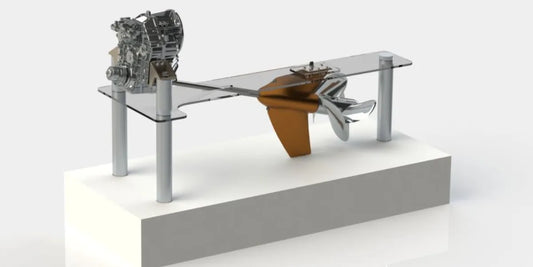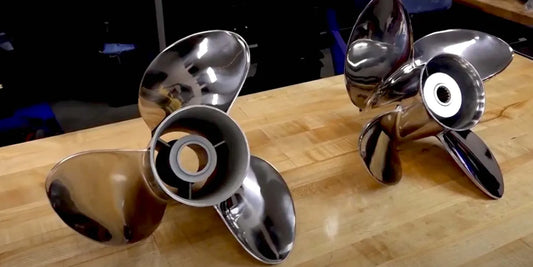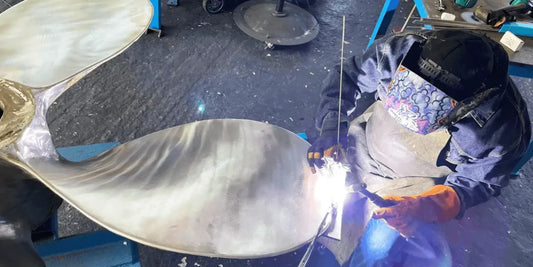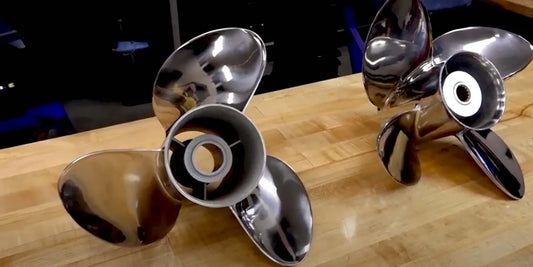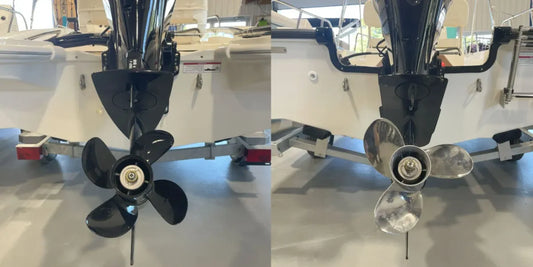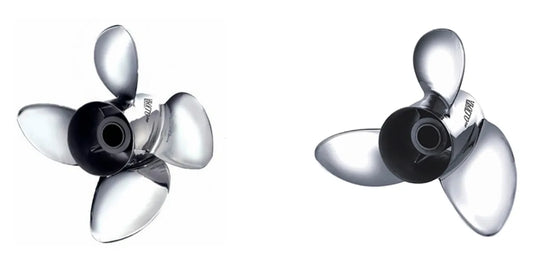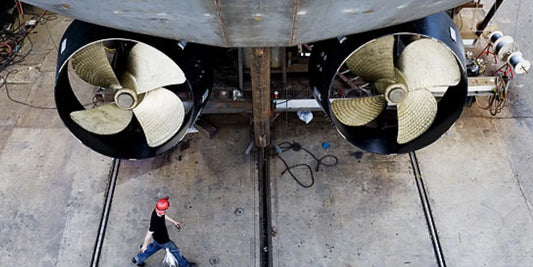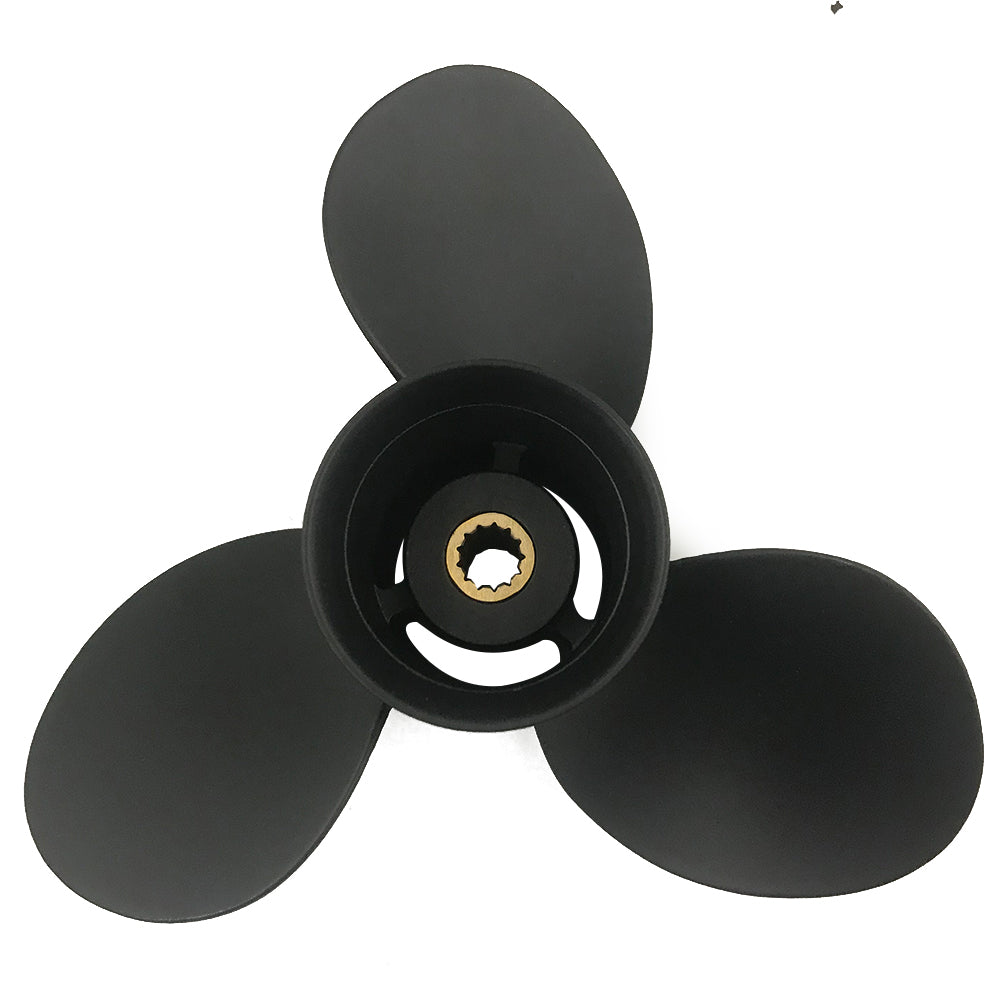When factoring in propeller options for your boat, the boat builder has but two choices: stainless steel and aluminum. Both carry their unique sets of strengths and drawbacks, whose selection significantly impacts boat performance, fuel consumption, and durability. So which way do we choose? This article delves into the stainless steel vs. aluminum propeller debate and helps you understand the strengths of each type, their usage applications, and factors to consider in today's boating world. By the end of this analysis, you should be very clear about choosing the propeller that fits your individual boating requirements in 2025.
Understanding Propeller Materials

What is a Stainless Steel Propeller?
A stainless-steel propeller is a type of boat propeller that is highly durable and very efficient in operation. Stainless steel alloys, being generally considered the stronger alloy with corrosion resistance, persevere through conditions that demand high performance. They have been preferred for their outstanding longevity and superior performance in both fresh and saltwater. These propellers, made from stainless steel, are more rigid than those made from other materials, such as aluminum, which reduces flexing during propulsion and thus improves propulsion efficiency.
Data have demonstrated that a stainless steel propeller can improve the fuel economy and optimize speed, particularly at higher RPMs, compared to an aluminum one. Because any of the propeller blades may be bent or broken by subsea debris, stainless steel propellers tend to be favored by boaters for the sake of long-term reliability. They usually carry a higher upfront price but offer more extended periods of maintenance than any other type, making it a wise choice for those who value performance and resilience in water.
What is an Aluminum Prop?
The aluminum propellers, due to their cheaper price point and the flexibility of use with an aluminum-based material that is both heavy and lightweight yet sturdy, are a craft of a boat propeller. Such propellers find widespread application among various watercraft due to a balance of performance and a fair price. Aluminum props are generally suited for low- to mid-power applications and are marketed primarily to recreational boaters and casual anglers. While aluminum may present less durability in certain situations compared to stainless steel, it is much easier to repair and maintain. Their lightness also offers reasonable day-to-day fuel efficiency and acceleration, making them a cost-effective solution for almost every boating application.
Comparison of properties of materials
Two primary choices are available: aluminum and stainless steel. Aluminum props offer a cheaper and lighter option, preferred mostly for everyday boating, as they are more affordable and easier to repair. Statistics show that aluminum props are anywhere between 30-50% cheaper than their stainless steel counterparts, making them a popular choice for casual users and those on a budget. Since aluminum is a relatively soft metal, propeller blades tend to get damaged easily when colliding with debris and underwater obstructions.
In this regard, stainless steel propellers have evolved into the next phase, offering both enhanced durability and performance. They encounter more powerful horsepower applications and harsher conditions, making them more suitable for professionals or ardent boaters seeking extended life and heightened precision. Testing suggests that stainless steel props decrease flex under load better than aluminum, improve mending efficiency at speed, and maintain constant acceleration under change. The initial cost is relatively high; hence, with intensive usage, the durability and performance advantages prove the investment worthwhile.
Ultimately, the decision depends on the particular use of the boat. For high-performance boats, where advancements in efficiency must take precedence, stainless steel presents an almost irresistible argument. Aluminium will take care of those who go for the cheaper and more manageable. Weighing these pros and cons of materials allows for making an informed decision based on specific marine applications.
Durability and Performance Factors

Durability of Stainless Steel vs Aluminum
The differences in durability between stainless steel and aluminum have a significant impact on their applications in various marine uses. Stainless steel has excellent strength and corrosion resistance properties and as such is preferred in severe environments that involve saltwater exposures. The chromium content dissolves and redeposits onto the surface as a thin, clear, chromium oxide film that protects the steel the steel from rusting. It further prevents the steel from wearing out against continuous stress and abrasive conditions.
Aluminum is a lightweight material with corrosion resistance. It is softer than stainless steel so the oxide layer on its surface protects it from damage and environmental wear. It is, therefore, adopted more for parts subjected to weight reduction while maintaining structural integrity. Nevertheless, aluminum can be weighed down and damaged more easily under impact and heavy loads compared to stainless steel.
Data suggests that stainless steel maintains its structural properties over a long period and is subjected to high pressure; aluminum, conversely, performs better where weight efficiency counts. To best achieve durability and perturbing ability, one needs to understand the load demands and the environmental conditions under which an application has to perform.
Performance on Different Boat Types
When evaluating the performance of materials like stainless steel and aluminum on various boat types, it is essential to consider the functional and environmental requirements of different boat classes. For pleasure boats, which can include speedboats or sailboats, aluminum is often preferred because it is lightweight, aiding in fuel efficiency and ease of handling. Aluminum's corrosion resistance is well-suited for boats regularly exposed to freshwater lakes and rivers.
On the contrary, commercial vessels, which include fishing trawlers and cargo boats, must afford the luxury of stainless steel parts. It provides much more protection against the degradation to which saltwater, heavy loads, and harsh weather keep subjecting it. The durability further ensures that this element lasts longer structurally and incurs lower maintenance costs over time.
Hybrid boats may incorporate both commercial and recreational features, thereby combining elements of both materials. Aluminum may be employed for hulls to lighten them, whereas stainless is used as reinforcement in areas that carry much stress, such as brackets, rails, and fittings, for the utmost structural integrity. Identifying the operational environment and its requirements will help determine which material configuration should be chosen for optimal performance.
Corrosion Resistance Comparison
When comparing aluminum and stainless steel, corrosion resistance is a crucial factor to consider, particularly in marine environments and industries where they are frequently exposed to moisture and salt. Stainless steel, particularly Grade 316, is considered one of the most corrosion-resistant varieties because the chromium present in the metal can form an oxide layer that acts as a passive protective barrier. For marine applications, where the use of materials is long-term, including those where the component will be underwater or subjected to high salinity, stainless steel is an ideal choice. However, stainless steel is not entirely corrosion-free, as temperature, exposure to chemical agents, and inadequate maintenance can lead to pitting and crevice corrosion.
Aluminum, unlike titanium, can naturally form a thin oxide layer when exposed to air, which provides some corrosion resistance. These aluminum alloys, primarily marine-grade ones such as 5052 and 5083, are treated to resist adverse reactions during exposure to saltwater. Yet, aluminum shows greater susceptibility to galvanic corrosion when in contact with a dissimilar metal, especially if moisture or a saline environment is present. To lessen such possibilities, one can insulate dissimilar metal contacting surfaces or employ sacrificial anodes.
Generally, in instances where one needs to rely on corrosion resistance over the long haul through activities exposed to harsh marine conditions, stainless steel certainly stands out as the better option. On the other hand, aluminum offers a good balance of corrosion resistance, weight savings, and cost. Hence they tend to be used wherever performance efficiency and weight saving are of prime consideration. The choice of metals will, thus, depend upon the actual environmental requirements, maintenance availability, and priorities of the design on the job.
Stainless Steel vs Aluminum Prop: Cost Considerations

Price Differences Between Stainless and Aluminum Props
When considering price differences between stainless steel and aluminum propellers, it is essential to put the prices into the context of value and performance. Aluminum propellers, being less expensive, are typically sold in the range of $100-$300 for standard designs, thus appealing to buyers with limited budgets or casual boaters. To the contrary, stainless steel propellers made from premium materials and featuring enhanced durability will typically cost anywhere from $400 to $ 1,000 or more.
This long-term value stems from the high initial investment that stainless steel props must incur: they withstand wear and deformation better under stress. Wide variations in air or water flow may simultaneously characterize or provide a harsh operating environment. Their efficiency, in turn, helps improve fuel economy, providing an additional long-run operational cost saving. In terms of price and casting, aluminum props are less expensive, but they are prone to damage, such as bending or chipping, under challenging conditions, and are therefore prone to frequent repairs or replacements.
In the decision-making process, one should weigh considerations regarding the upfront budget, the frequency of use, and the type of environment in which the product will be used. Aluminum is cheaper and can suffice for a recreational scenario on calm waters. Stainless steel, on the other hand, is more expensive but justifies its price in applications requiring high performance or constant use in more aggressive waterways.
Long-Term Costs and Maintenance
Regarding long-term usefulness, the propeller must also be considered in terms of cost and maintenance. Their initial price does not reflect it, but stainless steel props have greater durability and resistance to wear, especially in adverse conditions or where debris is a recurrent problem. These attributes reduce the likelihood of costly repairs or replacements, resulting in a lower total cost of ownership over time.
Conversely, aluminum propellers are cheaper to buy but may require higher maintenance and replacement costs should they be placed under difficult conditions. These maintenance and replacement costs, which recur over time, inadvertently become more than the purported savings gained through initial cost reduction. Knowing the usage curve and environment can help the boat owner best weigh immediate affordability against the long-term value of their investment, ensuring optimal performance and a low cost of ownership.
Durability and Efficiency in Material Selection
When selecting the appropriate material, two key properties to consider are durability and performance efficiency. Stainless steel propellers are the strongest and most wear-resistant propellers for boaters who often ply rocky or debris-filled waterways. Tests have shown that stainless steel propellers frequently last longer than aluminum propellers, thereby reducing the frequency of replacements. The rigidity of steel enhances propulsion efficiency to some extent, which usually means saving a little on gas and getting a tad more acceleration.
Aluminum propellers, on the other hand, are lightweight and inexpensive but are not robust enough to withstand challenging operational environments. Aluminum propellers will get the job done reasonably well in calm, shallow waters, but tend to bend or become damaged when they encounter an underwater obstruction. There may be changes in performance as a result; that, coupled with repeated maintenance, will often prove more costly for the regular user.
Cost-wise, if one weighs cost against performance, data suggest that stainless steel propellers might provide greater long-run value to those working in harsh conditions. However, aluminum propellers present a practical alternative for occasional or recreational use. For optimal selection, boat owners should prioritize understanding their boating habits and the environments they frequently visit, to weigh the trade-off between initial investment and durability.
Choosing the Right Prop for Your Boat

Factors to Consider When Choosing a Propeller
Selecting the right propeller for your boat involves several key factors to maximize performance, efficiency, and durability. The following are the most important to consider:
Size and Pitch: Diameter and pitch are the two main parameters by which the propeller is measured. Hence, the diameter and pitch play an important role in the effectiveness of the boat. A larger diameter results in a greater load on the ship, while a smaller diameter provides quicker acceleration. The pitch is equal to the number of inches a boat would move in one rotation of the propeller. A higher pitch does well from the speed point of view, while a lower pitch performs better when towing or engaging in any other high-thrust activity.
Название и владелец компанния: Different engine and horsepower: In an ideal scenario, all propellers working with the engines need to be matched to their respective operating range (RPMs), so that the engine does not overwork or underperform in powering the boat. Refer to your engine manual for the recommended RPM ranges.
Material: The choice between aluminum and stainless steel is a crucial one. Aluminum propellers are economical, lightweight, and best suited for general recreational purposes. Stainless steel, however, offers better strength, high performance, and longevity, especially in high-demand or saltwater environments.
Boating Conditions: The kind of environment you usually find yourself boating in becomes the determining factor of a perfect propeller for you. Shallower water with lots of debris calls for aluminum props, which are relatively inexpensive to replace, while open waters require the heavy-duty strength of stainless steel. If used in saltwater, corrosion resistance is another factor to consider.
Blades: Propellers have anywhere from three to five blades. A three-bladed propeller will give you greater speed and less drag, whereas four- or five-bladed propellers give you more thrust and smoother handling, particularly in the case of heavier boats or while towing.
Performance Goals: Consider your primary goals—i.e., whether you are looking for speed, fuel efficiency, towing capacity, or load carry capability. Each performance goal can consequently have a set of optimum propeller characteristics, from pitch to material composition.
Ventilation and Cavitation: Whatever the case, avoiding excessive ventilation (basically, air escaping around the prop) or cavitation (vapor bubbles that damage the propeller) is crucial in maintaining performance and durability. Proper sizing and design of the propeller are considered among the preventive measures.
Keeping these factors in mind, boat owners can be able to make sound choices regarding their enhancements to ensure efficiency and longevity of their vessel. Regular maintenance and adjustment will continue to reward them while on the water.
Aluminum and Stainless Steel Prop Recommendations
It is best to evaluate specific needs and the boating environment before deciding between aluminum and stainless steel propellers. Aluminum props are readily available and relatively inexpensive, making them ideal for casual boating or those who want to keep costs low. They weigh less than stainless steel propellers, placing less strain on small engines, yet are sufficiently strong for most recreational activities in flat to moderate waters.
In contrast, stainless steel propellers have greater power, strength, durability, and performance in harsh conditions. These props provide excellent tolerance to high-speed impacts and corrosion, making them perfect for saltwater boats and high-performance motorboats. Stainless steel propellers may have a higher initial cost, but their durability and performance will definitely yield true value over time.
Several big considerations, like engine HP, purpose, and the sort of waters where you would usually plonk your boat down, can play a big role in determining the right prop for your boat. Aluminum is likely to be recommended for a boater seeking an economical option on inland lakes or for leisure cruising, whereas stainless steel is favored by those requiring maximum efficiency, optimal fuel economy, and overall robustness. Boat-style and ambience will tell the prop choice and, more importantly, determine the extent to which you fully enjoy the propeller's performance and life.
Common Misconceptions About Prop Material
A common misconception is that all stainless steel propellers are superior to aluminum ones. While stainless steel indeed provides more durability and top-notch performance in high-stress conditions, aluminum propellers are still capable of delivering results comparable to those of an aluminum propeller in recreational boating or environments with fewer hazards. Often, boaters neglect the importance of individual requirements, such as budget or boating locale, and even performance criteria, all of which hold a cardinal position when choosing the appropriate material.
Another false belief is that there is an inherent gain in fuel efficiency from installing a stainless steel prop. It depends very much on the engine setup, boat size, and the speed at which the boat is operated. In the case of lighter and smaller boats, the difference in efficiency is probably negligible between an aluminum and a stainless steel propeller. The real efficiency is obtained by choosing the right propeller pitch and blade configuration for your specific boat, irrespective of the material.
Lastly, there is a misconception that prop materials heavily influence the overall safety of the vessel. While material strength can sometimes lessen damage, safe boating practices, the upkeep of equipment, and being alert to the conditions of the water are far more significant factors that lead to greater safety. Emphasizing such nuances would give boaters a warning against erroneous building materials myths, allowing them to focus on being functional and cost-effective.
Future Trends in Propeller Materials

Innovations in Stainless Steel and Aluminum Props
When pondering innovations in stainless steel and aluminum props, the advancements in material technology drive my excitement. Stainless steel props are increasingly becoming refined through the application of advanced metallurgical processes. These enhance its durability, corrosion resistance, and the ability to withstand ever harsher working conditions. Newer stainless steel alloys, for instance, have been designed with a greater strength-to-weight ratio, allowing them to be used in higher-powered engines where efficiency and reliability are crucial. Spearheading more exotic blade designs with recognized hydrodynamic performance criteria, many manufacturers have also embraced precision casting methods, offering the very curves that make for smoother rides and better fuel economy.
Conversely, aluminum props have not lagged in the evolution, while maintaining cost-effectiveness as the primary concern. New-age aluminum alloys are designed to be resilient through the incorporation of trace metals such as titanium or magnesium, while maintaining moderate prices. What I find most striking is the increased utilization of computational fluid dynamics (CFD) in prop design. These methods enable the manufacturer to maximize blade geometry, thereby maximizing thrust while reducing cavitation occurrences. Altogether, with state-of-the-art coatings that enhance the longevity of aluminum props by resisting abrasion and environmental attacks, we see a somewhat classic and budget-conscious aluminum solution in the eyes of the boating community.
Both of these materials have undergone 3D vibration tests and performance simulations to simulate real-world conditions. These ensure that while propellers remain functional under all conditions, they also meet the performance criteria for specific applications in modern boating. Stainless steel and aluminum prop innovations are examples of how niche technological improvements push the limits of reliability, efficiency, and affordability in marine equipment.
Environmental Considerations for Material Choices
Environmental factors associated with material choices for propeller design should include sustainability and ecological impact. Stainless steel and aluminum are considered environmentally friendly mainly due to their long lifespan; how their environmental footprints compare must also be taken into account when making a decision. Stainless steel is prized for its longevity and corrosion resistance, thereby limiting the need for replacements. The downside is that energy-intensive mining and smelting are involved in its production, thus contributing to carbon emissions. Aluminum, in contrast, is lightweight and typically has a high recycling rate, which could explain its suitability for green designs if utmost attention is paid to ensure that renewable energy and good mining practices are followed throughout all stages of sourcing and manufacturing.
Closing the loop on lifecycle impact is, in my mind, an absolute must. Materials that could be recycled and reused contribute less to landfills and help prevent the depletion of raw resources. Hence, a choice of propeller material with a higher recyclability rate supports the circular economy, thus closing the loop on today's environmental standards. Furthermore, avoiding coatings or treatments that release harmful chemicals into marine ecosystems during either manufacturing or usage would go a long way toward alleviating such pollution concerns.
Nach dem allerwichtigsten Gegenspiel zwischen Leistungsanspruch und Umweltverantwortung. In this manner, leading development could seek greener alternatives or improve current manufacturing processes to meet both quality and efficiency requirements, as well as the growing demand for sustainability in marine equipment.
Predicted Changes in the Boating Industry
For me, the boating industry is on the verge of a significant shift, primarily driven by technological advancements and the global trend toward sustainability. Perhaps the single most prominent change is in the broader implementation of electric and hybrid propulsion systems. Increased emissions restrictions and high fuel costs are putting much pressure on these developments. We can say that manufacturers are heavily investing in battery technology and alternative fuel systems to produce boats that are more efficient and environmentally friendly without compromising performance.
Another significant change will involve smart technology integration into boating. From autonomous navigation to IoT diagnostics and maintenance, boats are becoming increasingly connected. This would even enhance their safety and convenience while reducing the manual labor involved in monitoring and operating core systems. In this manner, the improvements would speed up the boating experience, increasing efficiency for both recreational boaters and commercial operators.
Ultimately, I believe that material innovation will also play a significant role in reshaping this industry. Lightweight, durable, and sustainable materials are poised to replace traditional ones, placing a lighter burden on the environment and enhancing the overall performance of the vessel. With these changes, the boating industry can join the sustainability bandwagon, all while catering to a modern-day consumer who is looking not only for functionality but also for something that speaks to their environmentally friendly intentions.
Reference Sources
-
Prop Bites: How To Choose Between Aluminum and Stainless Steel Props - Discusses cost, performance, and durability differences between the two materials.
-
Stainless Steel vs Aluminum Prop: What's the Difference? - Highlights key factors like durability, speed performance, and affordability.
-
Is an Aluminum or Stainless Steel Propeller Right For You? - Provides insights on choosing the right prop based on engine size and usage.
-
2025 Stainless Steel Vs. Aluminum Propellers: Choosing the Right One - Explores cost-efficiency, weight, and performance under high-stress conditions.
-
Stainless Steel vs Aluminum Prop: What's the Difference? - Examines price, repair costs, and material-specific advantages.
Frequently Asked Questions (FAQs)
What is the difference between aluminum and stainless steel props?
The main distinction between aluminum and stainless steel lies in their material characteristics. While the capability of a stainless steel prop to deliver top speed and performance is attributed to its outright strength and the ability to handle higher-horsepower motors, aluminum props are usually lighter and cheaper, and are thus selected by owners of lighter motors or casual boaters. From the perspective of durability, stainless steel tends to last longer, especially in saltwater, whereas aluminum may corrode more quickly. So, it really depends on what type of use you intend for your boat and what performance level you want.
When would I want a stainless steel prop on my boat?
There are several advantages that a stainless-steel propeller can have over an aluminum prop. In this case, stainless steel is stronger, which enables thinner blades that combine to produce a higher top speed and better efficiency. While any damage to these props is markedly less common, they also usually have very long life spans. This way, they are most suitable for practically any boater with a high-performance setup or one who frequently navigates shallow water. One can argue that stainless steel costs more upfront, but with respect to fuel economy and performance, many will say that the stainless prop is worth its price.
What type of prop is best for a 150 hp outboard?
There is quite a debate surrounding the discussion of the best prop choice for a boat with a 150 hp outboard. However, stainless steel props are often recommended because of their power-handling capability, performance, and durability. With four blades, a stainless steel prop can provide a great holeshot and fuel efficiency, making it ideal for those who want to squeeze every bit of performance out of their boats. Stretching the budget or light duty, the aluminum high-performance prop is also an option; it should work just fine. The available prop models and how well they match the hull of your boat for your purpose should be given consideration.
How does prop blade design influence performance?
Since the design of the propeller blades significantly contributes to the performance characteristics, including acceleration, top speed, and fuel efficiency, the blade design in the propeller shaft must be carefully considered during propeller selection. The thinner blades in a stainless steel prop generate less drag in the water, allowing for higher speeds and better performance. The aluminum props generally allow for thicker blades, which in some cases may result in a slight performance loss. Finally, the number of blades affects holeshot and handling. Is the last factor concerning blade design the knob to choosing a prop for your specific boating needs?
Are there any drawbacks to the use of aluminum props on saltwater boats?
Yes, saltwater boats pose certain risks of corrosion on the aluminum props. Being more susceptible to damage from saltwater, aluminum corrodes more quickly, resulting in reduced performance and a shorter lifespan. Apart from these factors, an aluminum prop may not withstand high stress as well as a stainless one, especially when subjected to severe incidents. The choice of stainless steel is, therefore, generally recommended by crane operators for saltwater applications, promoting durability and the longevity of the equipment. Combined with the latest information from Google Search, this helped me present particulars and data while avoiding the phrase results based on Google searches.


